This was published 7 months ago
One man, two ex-wives and the $50m sushi sale that changed everything
Susie Wong and Anna Kasman, along with Albert Lau, were instrumental in the explosion of sushi as a lunchtime order of choice. So how did the trio’s intertwined personal and business relations end up frayed – and in the Supreme Court of Victoria?
By Tom Cowie and Stephen Brook
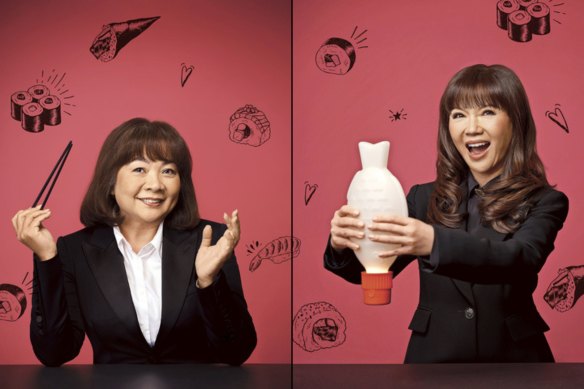
Left: Sushi Sushi co-founder Susie Wong thought the company’s 2019 sale would allow her to retire at 50; instead, she says it led to a “train wreck”. Right: Anna Kasman contends she helped turn the business into a fast food giant.Credit: Benny Capp
One of Susie Wong’s favourite aphorisms is that the customer buys with their eyes. We’re at Wong’s seafood bar, Maguro, at The Glen, a large shopping centre in Melbourne’s east. The rich shades of colour that pop from Maguro’s delicately arranged platters are good enough to be in a Tokyo department store. A staffer in turquoise gloves is doing battle with a stubborn oyster, twisting his shucking knife until the mollusc snaps open. It’s a chilly morning in Glen Waverley, a suburb known for its large Asian population (38 per cent reported Chinese heritage in the last census), but the manufactured climate of The Glen is a bland 23 degrees. This is another of Wong’s laws of retail.
“I always believe that 23 degrees, seven days a week, is best for business,” says Wong, who, despite this commentary, is dressed for the cold outside in a black jacket, grey turtleneck top and patterned scarf. “People say, ‘Oh, I love going to the market,’ ‘I love the sun.’ Yes, you do – but not every day.”
Inside Maguro’s refrigerated display is something just about every Australian has eaten at some point: sushi. An umbrella term for a range of Japanese dishes, the sushi we’re talking about are the hand rolls filled with cooked tuna, grilled chicken, deep-fried prawn and the like that you’ll find in almost every food court around the country (don’t forget the wasabi, pickled ginger and soy sauce).
Wong, 57, is one of two Malaysian-born founders of Sushi Sushi, the chain of stores that grew from a single outlet to more than 160 nationwide. A shopping centre without sushi may seem unthinkable today, but it was a novelty when the first store opened in 1998 in nearby Box Hill. In the past, sushi was mostly ordered in expensive Japanese restaurants – in Western
popular culture, it stood for luxury and Wall Street-inspired excess.
According to Wong’s telling, a sandwich shop at the Box Hill Central shopping centre was the inspiration for something different. “I looked at the customers queuing up and all they could buy was a chicken sandwich, a tuna sandwich, a salad sandwich,” she says. “We wanted those customers.”
The idea was simple. Substitute the sliced pieces of raw tuna, salmon and kingfish for more “Australian” ingredients. Japanese itamae (head chefs) may have been aghast, but one early flavour experiment was to strip a supermarket roast chicken and coat the meat in teriyaki sauce. Each roll was cut in half and would sell for a couple of dollars, matching the price of a sandwich.
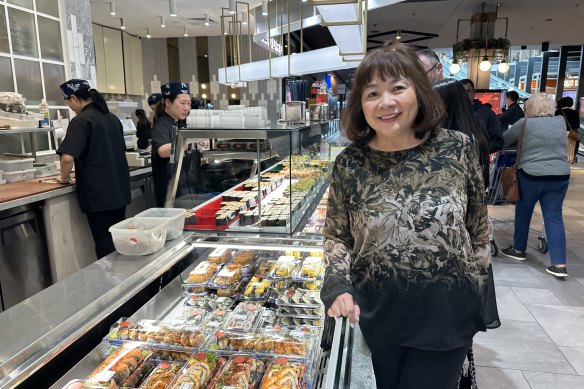
Wong’s seafood bar, Maguro, at The Glen in Melbourne’s east.
We all know what happened next. You can hardly visit a suburb, town or service station roadhouse without finding sushi, no matter how far from the ocean. Its healthy reputation (questioned by some dietitians) has cross-generational appeal; office workers live on it as a cheap lunch option, as do parents. Australia has even developed its own version of sushi hand rolls – the fillings and sausage-roll length are unique to our shores. “We tend to like that shape in Australia,” says food writer and broadcaster Adam Liaw. “If you think of the old-school, country Chinese restaurants, they have those large spring rolls.”
You’d assume all this made Wong a very wealthy woman. But things didn’t turn out that way, after a series of events she now calls the “train wreck”. In 2019, after Sushi Sushi was sold without her involvement to private equity investors for the life-altering sum of almost $50 million, an aggrieved Wong took action in the Supreme Court of Victoria, seeking a 10 per cent share of the proceeds. The other founder, Wong’s ex-husband Albert Lau, didn’t get anything from the sale, either – but, as we’ll hear, he’s much more at peace with what unfolded after he signed the company over to his second wife, Anna Kasman, as part of their 2016 divorce settlement.
Wong lost the court battle. “I thought I’d be set,” she says between sips of her coffee, her usual cheerfulness dappled with a sense of regret. “I could take that money and go and live my best life. I could retire at 50 – that’s what I thought. But, because I lost everything, I had to start again and walk away.“
This isn’t just a story charting the origins of one of Australia’s most popular fast foods. It’s also one about a small business that grew beyond its founders’ wildest dreams, the relationship breakdowns that followed that triumph and the legal importance of making sure agreements are put down in writing. Otherwise, you could end up on the witness stand, and it’s your word against theirs.
Across town, in the heart of the CBD, Melbourne Emporium is bustling. It’s Friday lunchtime and a mix of shoppers, office workers, teenage boys, uni students and mums with toddlers are queuing to buy sushi. A diminutive figure wrapped in a black North Face puffer coat is attentively surveying the busy scene at the new Sushi Jiro outlet, one of more than 20 across Victoria, Queensland and Western Australia. She could be any other upmarket shopper but for the fact that her personal wealth is estimated at nine figures and Sushi Jiro is entirely hers.
Anna Kasman, the 53-year-old “sushi queen” – a newspaper descriptor, it turns out, that is very much not to her taste – spots us and walks over, smiling. Kasman, who has invited us for lunch, is dressed entirely in black: dress, boots, stockings, bag, even the bands wrapped around her right wrist. One is a discreet Prada strap that makes electronic payments via a chip, the other a fitness monitor for her home workouts (“I want to fit everything into 45 minutes”). Her sole concession to flashy jewellery is a silver Rolex, the watch face ringed with diamonds.
Kasman carries a luxe handbag and plain A4 notebook (she wants our thoughts on the food) and is a mix of friendly and nervous energy. Our tour starts at Sushi Jiro’s express takeaway counter, where fat hand rolls and attractively boxed sashimi are sold next to more unfamiliar fare, including nacho cheese tuna rolls (crowned with corn chips) and other exotic varieties with names like “Lion King” and “Himalaya”. Kasman is trying to set a new standard in the ultra-competitive sushi market. “Hand rolls are no longer an innovation,” she says.
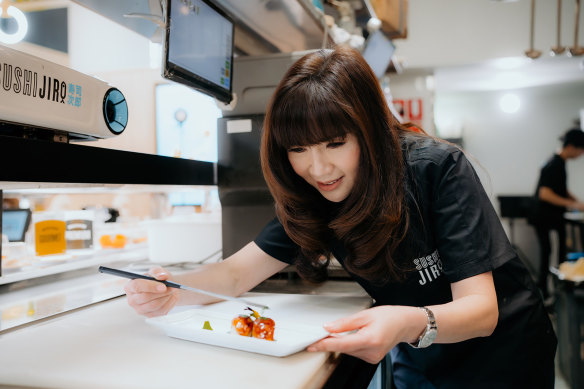
Kasman at Sushi Jiro, which she bought in 2022 from food entrepreneur David Loh and chef Tomohiro Suzuki, who opened the first store in 2017.
We move into the kitchen, where the staff stiffen slightly, then to the adjacent restaurant with a centrepiece sushi train. This snaking conveyor belt of convenience, surrounded by ring lights and blond wood panels, is what drew Kasman, Wong’s one-time close friend, into buying Sushi Jiro in 2022 from food entrepreneur David Loh and chef Tomohiro Suzuki, who opened the first store in 2017. “It was a very big decision,” she says. “I discussed it with my two children, a long conversation about the pros and cons. Do I really want to get back into it again? The perception is, it’s still sushi. But everything is just so different. I was just mesmerised.”
A banquet lunch has been prepared for us, starting with aburi salmon salad and chawanmushi (a salty, Japanese-style steamed egg) before ending with the innovative “nori tacos”. As we crunch through sheets of nori seaweed, battered and bent in U-shapes, filled with soft shell crab and spicy chicken karaage, we realise our host is eating from a completely different menu. Kasman reveals she no longer eats much fish; she’s mostly vegan, primarily because she prefers it. “I know what that tuna tastes like because I’ve eaten it before,” she says, pointing at a plate of blushing pink sashimi as it glides by on the sushi train. “I can tell the quality from the colour.”
Halfway through lunch, after we’ve discussed Sushi Jiro’s expansion plans, the mood shifts. In our dealings to this point, Kasman has been reluctant to speak about the past, particularly Wong’s Supreme Court action and the fallout. It’s clear she regards it as traumatic. But now she’s willing to address the early days of Sushi Sushi, her close relationship with Wong’s ex-husband, Albert Lau, and how they fell in love and got married.
Kasman also wants us to know that Lau involved her in the business from day one, and that it was her financial acumen that helped turn it into a takeaway food giant. “When I moved [to Australia from Jakarta], it was quite clear that I would be in the business,” she says. “Albert saw that the business needed me.”
In the 1980s, Australia fell for Japan. Lingering enmities from World War II were pushed to one side as cultural and economic ties blossomed. Japanese politicians came on trade missions seeking to cuddle a koala; Made In Japan lacquerware was a thing; electronics brand National changed its name to Panasonic; the Japanese went crazy for Ken Done and Gold Coast property; and Tak Nishizawa, the local managing director of Kikkoman, pondered how to sell more soy sauce. His answer was to teach middle Australians about Japanese food. But traditionalist chefs lacked appeal with housewives, so Nishizawa found home economics graduate Brigid Treloar and hired her in 1988 to conduct cooking demonstrations, including sushi, at the Sakura Japanese supermarket in Castlecrag, on Sydney’s lower north shore.
They were making hosomaki, exquisitely cut, thin hand rolls containing a single ingredient, such as cucumber. “That’s how it was always done,” Treloar tells Good Weekend. Training to become a sushi chef typically took seven years. “Imagine how offended they were when Australians were saying, ‘We can knock it over in a 45-minute class.’ ”
Sushi was soon taking its first steps into the mainstream. In 1995, Toshihiro Shindo and his wife Maiko had opened Sushi-Jin – now considered the shop to first popularise lunchtime takeaway hand rolls in Australia – in a food court near Melbourne’s Chinatown. The following year, Sushi World opened in Sydney’s Chatswood. “[Shindo] was the first one to sell sushi,” Susie Wong says. “But, of course, he didn’t grow to 150 stores. He didn’t put it in shopping centres.”
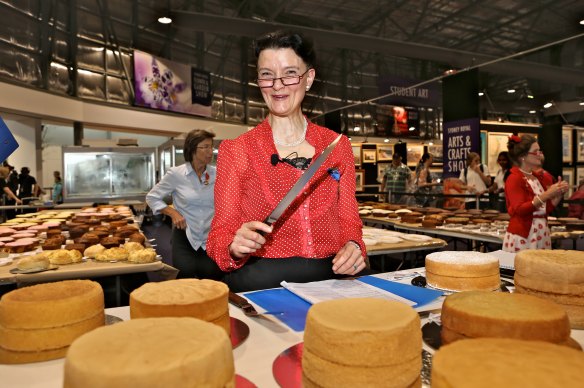
Brigid Treloar ran sushi classes for Kikkoman after being hired in 1988.Credit: Fairfax Media
Wong grew up in Kuching in Malaysia, the oldest of four siblings. She came to Australia in 1984, when her ethnically Chinese family sold everything to escape the pro-Malay government and moved into the local fish industry. Filleting and gutting was hard work, so Wong got a job packing containers of crispy lemon chicken and sticky sweet and sour pork at a takeaway place called Asian Hut. That’s where she met Lau, also from Malaysia’s Sarawak state.
It’s something we’ve wondered about when researching this story, that none of the main characters is Japanese – and it surprised us to learn that sushi is thought to have originated in China. “Sushi may be associated with Japan,” writes Eric Rath, a history professor at the University of Kansas, in Oishii: The History of Sushi, “but sushi was never solely a Japanese dish.” Opinions differ on how sushi got to Japan, but historians believe it dates back in Asia at least 2000 years, when salted rice was used to cure fish via lactic-acid fermentation. The first written accounts were in Chinese – one third-century dictionary included a character pronounced zha, defined as “fish, salt and rice”. The types of sushi we recognise today, such as hand rolls and nigiri, were later developed in Japan during the Edo period (1603-1868).
Soon after meeting, Wong and Lau started dating and were married at 19. Divorce followed at 21, but it was amicable – they used the same lawyer – and they made the unusual move to go into business together. “They were a great team,” says Wong’s sister, Cindy. After other ventures, they opened the first Sushi Sushi at Box Hill Central in early May 1998. Lau took the financial risk but promised Wong a 10 per cent profit share, according to the court evidence of them both.
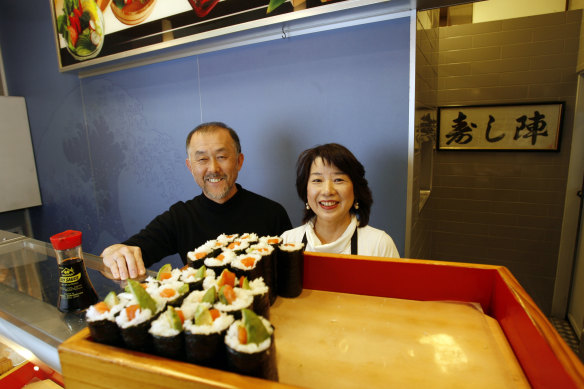
Toshihiro Shindo and wife Maiko opened Melbourne’s Sushi-Jin in 1995, the first lunchtime hand roll shop.Credit: Angela Wylie
The store was an instant success and expansion followed a year later at Chadstone, Australia’s biggest shopping centre. Wong was the lease negotiator and agreed to take a space in the upmarket fashion area, near Myer and David Jones. “That’s when everyone started eating sushi,” she says.
By this point, Lau had married Kasman. While Wong is adamant there are only two founders of Sushi Sushi, and the Supreme Court judge agreed with her on that, Kasman disputes any suggestion she joined well after it was established. “I knew about it beforehand,” she says of Sushi Sushi’s beginnings. “And of course, we [Albert and I] communicated a lot via – telephone as well, because I was still in Indonesia before I came here permanently.”
Kasman and Lau had met in the early 1990s, while she was studying business computing as an international student in Melbourne. The youngest of 10, she grew up in Cilacap, a small city in central Java. Her family exported bird’s nests, a delicacy made from the solidified saliva of swallows. After her studies, Kasman returned to Jakarta to work in banking and later resumed a long-distance relationship with Lau. In a romantic gesture, he started a new company, “Justry Kasman Pty Ltd”, accidentally misspelling her Chinese name, Jusri (Kasman appreciated the thought and still owns it today).
Wong and Kasman were like sisters; they were called “auntie” by each other’s children.
Despite her mother’s misgivings, Kasman left for Australia in late 1998 to marry Lau and join the family business. With the first of their two children at home, Kasman took charge of the finances, banking cash and arranging payslips (during earlier visits here, she’d been paying Lau’s past-due bills). Eventually she would set up 80 companies and trusts to manage Sushi Sushi’s corporate affairs and franchising, a complex web Wong’s lawyers would later take issue with. Lau was in charge of operations, visiting the fish market at 4am every day, while Wong’s role was to find new stores and deal with shopping centre landlords. For this, Wong was paid a salary, as well as annual bonuses, often in cash, that her lawyers argued was evidence of the profit-share agreement.
It’s fair to say this business relationship was a bit bizarre: a husband, his wife and ex-wife working in simpatico. Sushi Sushi’s ex-CEO Scott Meneilly, who joined the company in 2017, told the court it was a “little unusual” and that he didn’t understand the structure at all. Adding complexity, their personal lives were also intertwined. They shared birthday celebrations and Christmases together. There were group holidays to Aspen and Queensland. Wong and Kasman were like sisters; they were called “auntie” by each other’s children. For a while, it was wildly successful as more and more stores opened, and the profits rolled in. Then it all came to an end.
In March 2019, The Australian Financial Review reported that Sushi Sushi had been sold to Sydney-based investment firm Odyssey Private Equity in a deal that would turn out to be worth $50 million. The woman quoted as “founder and owner” was Kasman. “I am very proud of what we have achieved, and I am very grateful to our dedicated and passionate team and franchise partners,” Kasman told the AFR.
The following month, Wong filed her legal action in the Victorian Supreme Court, suing Kasman for breach of contract and asking for 10 per cent of the sale price. By that stage, their relationship had broken down – they would never speak again.
Lau and Kasman had also split by then, and as part of their matrimonial settlement, $110 million worth of assets needed to be divided. That included Sushi Sushi and Fish Pier, a smaller chain of seafood shops Lau had started, and real estate. It took four years for the divorce to settle. “It was an ugly separation,” is how Wong put it in her Supreme Court witness statement. Lau described it as a “difficult period and emotions were running high”.
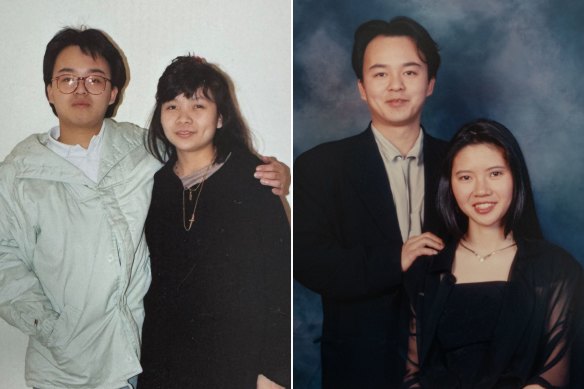
Left: Albert Lau and Susie Wong, who married at 19, divorced two years later but went into business. Right: Lau and second wife Anna Kasman; the couple divided $110 million of assets when they split.
The final matrimonial split was 70-30 in Kasman’s favour. She ended up with all of Sushi Sushi, then valued at $38.9 million, and the family house in Toorak, while Lau got Fish Pier, worth $3.8 million, and some of the other property. Lau said he was happy to leave Sushi Sushi without a share. “Money is not what motivates me,” he said in his witness statement. “Making customers happy is what I am passionate about.”
In her witness statement, Kasman said the settlement “acknowledges that my post-separation contribution substantially grew the Sushi Sushi business”. Her wealth has since grown to include office buildings in Bourke Street (bought for $34 million), Collins Street ($78 million) and a second Toorak mansion ($40 million).
As sole owner after her divorce, Kasman brought in a new leadership team, including Meneilly from Retail Zoo (owner of Boost Juice and other food brands) to get it ready for sale. That led to a conflict with Wong, who felt she was being pushed out from her role of maintaining relationships with landlords and franchisees. “With Albert gone, I started to get very nervous about what would happen to my interest in the business,” Wong said in her witness statement. “By that stage, my relationship with Anna had become strained. She had become very distant, secretive and she started to exclude me from the Sushi Sushi business.”
In late 2018, with speculation rife that Sushi Sushi was for sale, Wong and Kasman met at a Mount Waverley cafe, where Wong claims to have made the last of several requests to be paid out but was rebuffed (Kasman denies she was ever asked). “After selling the business, she turned around and she said to me, ‘You don’t own any of this,’ ” Wong tells Good Weekend. “She said, ‘You have to take this on with Albert.’ I said, ‘No, no, no, no, we had a deal.’ ”
Crucially, there was no written evidence that would prove Wong’s case. Like many of her early arrangements with Lau, nothing was put down on paper. Wong now sees this as naive but back then, she wasn’t concerned. She trusted Lau that the promise would be kept. “If you shake my hand, I’ll honour it, like, do or die I’ll make sure that you will get it delivered,” she says.
It’s hard not to wonder why Wong didn’t make her claim at the time of Lau and Kasman’s separation, rather than waiting until after their financial settlement, when Kasman had full control of Sushi Sushi. Wong’s sister, Cindy, says Wong was hopeful things would work out – she and Kasman were still friends at that point. “When [Lau] signed away Sushi Sushi, he effectively signed away Susie’s share,” she says.
In late October 2020, Melbourne was in its second COVID-19 lockdown. The AFL grand final had left Victoria for the first time ever (Richmond and Geelong played off at the Gabba in Brisbane). Also closed: the Victorian Supreme Court in Melbourne. Grand 19th-century Renaissance Revival architecture with intimidatingly tall ceilings gave way to trials conducted via Zoom calls and “I think you’re on mute, your honour.” It was in this setting that a fight for Sushi Sushi’s millions played out.
For those watching, it was like an unusually tense working-from-home meeting: Anna Kasman sitting in a high-backed chair in her home study in Toorak, a row of three polished ornaments on a shelf behind her, as Susie Wong’s barrister, Albert Monichino, KC, asked questions. The trial pulled back the curtain on Sushi Sushi’s operations, including the unusual relationship between its three main players. But the moment on which the whole case hinged was said to have happened in mid-December 1999, soon after the opening of the second Sushi Sushi store at Chadstone.
According to Wong’s evidence, the business did not yet have a head office, so it was not unusual for important discussions to take place in-store. Lau and Kasman were there, according to Wong, as was Tommy Tran, one of the original sushi chefs who remained with the company for 16 years. Several topics were covered, including staffing levels over Christmas and New Year. A large order of fresh produce was expected for the busy holiday period.
Then came the key conversation, as remembered by Wong in her witness statement: “Albert said to me at that meeting, in front of Anna and Tommy, ‘You have 10 per cent so you better work all night on 23 December.’ ” It wasn’t much of a smoking gun. But Wong’s lawyers argued this comment indicated the existence of a tripartite agreement, entitling her to a share in the business.
When Sushi Sushi first opened, Lau put in the capital via bank loans and was the sole owner on company records. Both Wong and Lau gave evidence, though, that they agreed she would get 10 per cent of the profit. She now believes that this was a recognition of them founding Sushi Sushi together.
Lau said in his witness statement that he remembered telling Kasman at the beginning about his promise to Wong. “Anna questioned this,” he recalled. “I said to Anna that Susie and I had a successful history of setting up and operating businesses. Anna accepted this, although reluctantly. The issue was never raised again.”
Lau said he could not recall the Chadstone meeting and Kasman denied it ever happened. “If there was any reference to any third person being an owner or having a share in any of the businesses … I would remember such an
important claim,” Kasman said in her witness statement. In court, she added that she’d given birth to her first child two months before the supposed Chadstone meeting date, so was unlikely to have been out of the house.
Justice Jim Delaney took that argument into account when weighing up the evidence. “That Albert Lau would give to his first wife a 10 per cent … entitlement in the Sushi Sushi business, a short time after marrying his second wife, is improbable,” he said in his judgment, in which he found that there was no contract between the three of them. He added, “I am not persuaded that 20 years ago such a meeting took place or that such things were said by Albert Lau.” During lunch with Good Weekend, Kasman is unequivocal about the Chadstone meeting: “It never happened.”
He thought the store would turn over $400 on the first day. It did $1700.
There’s one person we’re yet to hear from. For months, our calls, texts and emails to Albert Lau go unanswered. The hope is that he can cast some light on what unfolded between Wong and Kasman at Sushi Sushi beyond what is written in court documents, although it seems like that will go unfulfilled. Then, as we’re wrapping up our interviews, the mysterious third member of this business and marriage triangle emerges from the shadows.
We meet a slight, neat man in low-key designer clothes at the entrance of the busy Square One cafe in the Rialto building on Collins Street. Kasman, who has arranged the meeting, is standing beside him. Lau, 57, explains that he’s been in Asia for a few months. “Obviously, you guys have been chasing me … do I give up?” he says, disarmingly. “It’s good to have extra friends, I guess.” Over coffee, Lau tells us how he arrived in Melbourne at 16 to attend high school and would travel from St Kilda across town to Box Hill to wash dishes at the Asian Hut restaurant and clean the grease trap. He recalls the freedom of Australia after his impoverished upbringing in Malaysia. “It was safe and the money was good,” he says.
He remembers buying a single rice cooker for the first Sushi Sushi in Box Hill because he thought the store would turn over $400 on the first day; it did $1700. Selling sushi at the start of its popularity here must have felt like having a hit music record, we say. He agrees. “Can you imagine the chaos?” he says. “Everything was rolled by hand.” He looks at the proliferation of Japanese restaurants now with a sense of gratification. “People used to think you had to go to McDonald’s after eating Japanese,” he says. But he doesn’t shower himself with praise. “I don’t think much of it. I’m proud of it, but I don’t go and brag.”
We’re half an hour into our conversation and Wong’s name still hasn’t come up. So, we ask, what about Susie? The atmosphere thickens. “She was looking after the leasing,” says Lau. “I don’t want to go into that. I’m happy to discuss my role. Everybody looked at it differently, right?” He gives credit to Kasman, sitting beside him, for helping grow the business: “She was good on the finance side, I’m good on the operations.”
Later, we circle back to the court case and how Wong got nothing. “It doesn’t matter, move on,” Lau says. “I am thinking about myself now. I am happy. That is the most important thing. You can say I am selfish. If you can’t move on, you will be stuck.”
Unlike Wong and Kasman, Lau has not decided to start a new sushi business. He enjoys playing golf (he is a member at Huntingdale Golf Club, a private course on Melbourne’s sandbelt) and waking up before sunrise to go to the fish market to buy produce for his Fish Pier chain. “Whatever in life you do: right, good, bad, up, down, it’s all just part of it,” he says. “You come with nothing, you go with nothing. Don’t forget that.”
In his analysis of the evidence, Justice Delaney described Susie Wong as “warm and friendly”. He saw Anna Kasman as a “most unsatisfactory witness” who presented as a “very competent, calculating and somewhat ruthless person”. He questioned the truthfulness of some of her answers during cross-examination and said Kasman’s description of herself as a founder when selling the business was totally false. “She was not a founder of the Sushi Sushi business,” he wrote in his judgment. “The founders were Susie Wong and Albert Lau.” (Lau has since expressed “surprise” at this statement, writing in an email sent through Kasman, “Although Anna was not permanently residing in Melbourne at the time of the opening of the first Sushi Sushi, her role in founding and building Sushi Sushi from the start was crucial.”) Despite his view of some of her evidence, Justice Delaney found in Kasman’s favour. “Those criticisms do not impact upon whether or not Susie Wong has discharged the onus that she bears,” he wrote.
Wong didn’t just lose in failing to prove there was a contract – the whole affair cost her $1.2 million, including $500,000 for Kasman’s costs. “That’s why I no longer believe in the justice system,” she says now. “I just wanted an outcome, but the lawyers wanted an income. And the more money you have, the more chance of you winning.”
At The Glen, she’s getting back on her feet with Maguro, which she started with her siblings and in which she only owns a small stake. The offering is
sophisticated (lobsters, sea urchins, fish heads); Australia’s tastes have changed. “I just want to open five really, really good sushi stores,” she says. “I don’t want 100 stores.” Soon, she will open a new champagne and oyster bar at Chadstone called Fishmonger as part of the centre’s revitalised fresh food and dining precinct, The Market Pavilion. It’s a homecoming of sorts: Chadstone was the location for one of her family’s first fish shops and, of course, the second-ever Sushi Sushi store. “Susie is a Chadstone stalwart,” says centre manager Daniel Boyle.
Despite how it all turned out – at Sushi Sushi; losing a friend she thought of as a sister; her failed gamble in the Supreme Court – is she happy now? “I try to be, because no one wants to do business with someone who’s not happy or who’s not positive,” Wong says. “Because I’m here constantly selling the business, selling the dream. People still need to eat, that’s the only thing I know.”
To read more from Good Weekend magazine, visit our page at The Sydney Morning Herald, The Age and Brisbane Times.